Patterns of use of advanced wound matrices in the Veterans Administration clinics
IF 3.8
3区 医学
Q2 CELL BIOLOGY
引用次数: 0
Abstract
Chronic wounds are a common and costly health issue affecting millions of individuals in the United States, particularly those with underlying conditions such as diabetes, venous insufficiency, and peripheral artery disease. When standard treatments fail, advanced wound care therapies, such as skin substitutes, are often applied. However, the clinical effectiveness, indications, and comparative benefits of these therapies have not been well established. In this study, we report on the usage of both acellular and cellular, single and bilayer, natural and synthetic, dermal, and epidermal skin substitutes in a VA hospital system. We performed a retrospective chart review to understand the ordering and usage patterns of advanced wound therapies for patients with chronic wounds at the VA Northern California Health Care System. We examined types of products being recommended, categories of users recommending the products, indications for orders, and rate of repeated orders. Neuropathic, venous, or pressure ulcers were the main indications for using advanced wound matrices. Only 15.6% of patients for whom the matrices were ordered had supporting laboratory tests. Exactly 34.3% of the ordered matrices were not applied. And the use of wound matrices resulted in increased costs per patient visit of $1018–$3450. Our study sheds light on the usage patterns of these therapies in a VA healthcare facility and highlights the need for more robust evidence-based studies to determine the true benefits, efficacy, and cost-effectiveness of these innovative treatment options.退伍军人管理局诊所使用先进伤口基质的模式
慢性伤口是一种常见的健康问题,影响着美国数百万人的健康,尤其是那些患有糖尿病、静脉功能不全和外周动脉疾病的人,代价高昂。当标准疗法失效时,通常会采用皮肤替代品等先进的伤口护理疗法。然而,这些疗法的临床效果、适应症和比较效益尚未得到很好的确定。在本研究中,我们报告了退伍军人医院系统中无细胞和细胞、单层和双层、天然和合成、真皮和表皮皮肤替代品的使用情况。我们进行了一次回顾性病历审查,以了解退伍军人事务部北加州医疗保健系统慢性伤口患者先进伤口疗法的订购和使用模式。我们研究了推荐产品的类型、推荐产品的用户类别、订单的适应症以及重复订单率。神经性、静脉性或压迫性溃疡是使用高级伤口基质的主要适应症。只有 15.6% 的患者在订购垫料时进行了辅助化验。34.3%的伤口垫未被使用。而使用伤口基质导致患者每次就诊成本增加 1018 美元至 3450 美元。我们的研究揭示了这些疗法在退伍军人医疗机构中的使用模式,并强调需要进行更有力的循证研究,以确定这些创新治疗方案的真正益处、疗效和成本效益。
本文章由计算机程序翻译,如有差异,请以英文原文为准。
求助全文
约1分钟内获得全文
求助全文
来源期刊

Wound Repair and Regeneration
医学-皮肤病学
CiteScore
5.90
自引率
3.40%
发文量
71
审稿时长
6-12 weeks
期刊介绍:
Wound Repair and Regeneration provides extensive international coverage of cellular and molecular biology, connective tissue, and biological mediator studies in the field of tissue repair and regeneration and serves a diverse audience of surgeons, plastic surgeons, dermatologists, biochemists, cell biologists, and others.
Wound Repair and Regeneration is the official journal of The Wound Healing Society, The European Tissue Repair Society, The Japanese Society for Wound Healing, and The Australian Wound Management Association.
 求助内容:
求助内容: 应助结果提醒方式:
应助结果提醒方式:


